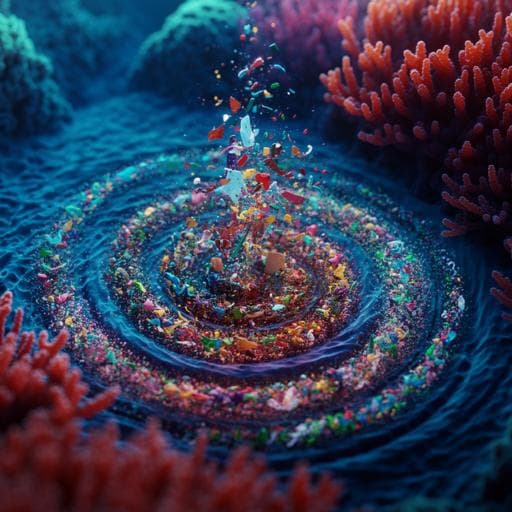
Environmental Studies and Forestry
An advanced analytical approach to assess the long-term degradation of microplastics in the marine environment
C. Maddison, C. I. Sathish, et al.
This groundbreaking research by Carbery Maddison and colleagues uncovers how microplastics degrade in marine environments, revealing rates up to 12 times higher than previously thought. The findings highlight the formation of new microparticles and provide essential data for plastic-specific risk assessments and policymaking.
~3 min • Beginner • English
Introduction
The study addresses the critical need to understand how microplastics (MPs) naturally weather and degrade in marine environments, where environmental conditions (lower temperatures, UV intensity, and constant seawater contact) slow degradation relative to terrestrial settings. Existing knowledge largely comes from artificial ageing studies or field observations lacking time-scale information. There is a mismatch between effect studies (mostly using virgin plastics) and real-world weathered plastics, and few studies have examined natural, long-term marine weathering across multiple polymer types. The research aims to provide comprehensive, time-series data to: (i) elucidate how natural marine weathering alters the physicochemical properties of plastics, (ii) track time-dependent changes in situ, and (iii) determine how weathering moderates chemical adsorption-desorption. These insights are intended to inform environmental risk assessment and plastics policy.
Literature Review
Prior work shows plastics undergo weathering via heat, UV, humidity, ozone, mechanical forces, chemicals, and microorganisms. Artificial ageing demonstrates flaking, cracking, roughness changes, and release of microscopic particles, but real-world weathering data with clear time-scales are scarce. Natural weathering studies exist but often cover limited polymer types and short durations. Changes in surface properties (hydrophobicity/hydrophilicity, charge, roughness) influence contaminant adsorption, interactions with colloids, and biofilm formation, while bulk properties (crystallinity, diffusivity, molecular structure) affect mechanical stability and adsorption-desorption. Fewer than 10% of exposure studies use environmentally weathered MPs, yet most report significant weathering effects on organisms, underscoring the need for realistic materials in ecotoxicological studies. Literature also indicates slower marine degradation due to lower temperatures and UV at the sea surface, and the role of microbes and dissolved constituents as catalysts. Overall, a significant knowledge gap persists regarding natural marine weathering mechanisms, rates, and implications for toxicity.
Methodology
Study design: A 12-month in situ marine weathering experiment was conducted to generate time-series data on multiple plastic polymers.
Model microplastics: Pre-production pellets, textiles, and foam particles (approx. 2500–4000 µm) from Australian suppliers included: LLDPE (mean 3674.05 ± 72.25 µm), PP (3462.52 ± 66.21 µm), ePS (~3000–5000 µm), PET (2630.15 ± 26.42 µm), PVC (3768.93 ± 19.86 µm), aramid textile fibres (PA; ~3000–5000 µm), and PCL (3489.53 ± 35.96 µm). Selection was based on market share in marine debris (for common polymers) and relevance (fibres, biodegradable polymer).
Field exposure: Ageing units were deployed in the top 100 cm of the water column at 10 sites in the Hunter Region, NSW, Australia, starting October 2018. Subsamples (~1 g, 20–30 pellets) were collected at 0, 1–2, 3–4, 5–6, 8–10, and 12 months. Units were maintained by removing fouling from outer surfaces to maintain flow. Samples were gently rinsed and vortexed in ultrapure water to remove loosely adhered material, air-dried, then pooled by site for analyses.
Surface and bulk characterization:
- SEM (JEOL JSM-7900F, 2 kV; magnifications 100x, 500x, 1000x and higher as needed; samples coated with ~2 nm Pt) to visualize surface changes and measure particle size from images.
- BET surface area (ASAP 2420, Micromeritics): ~1 g virgin and aged plastics degassed under vacuum for 3 h at 60°C (PCL at 40°C). BET model used; for ePS, a single-point method was used due to volume shrinkage under vacuum.
- ATR-FTIR (PerkinElmer Spectrum Two): 4000–400 cm−1, 4 cm−1 resolution, 8 scans; representative 3–5 pellets per time point; multiple locations per pellet; spectra baseline-corrected and normalized. Indices calculated: hydroxyl (O–H, 3100–3700 cm−1), carbonyl (C=O, 1600–1800 cm−1), and carbon–oxygen (C–O, 1000–1200 cm−1).
- XRD (Empyrean, Malvern Panalytical; Cu Kα1 λ=1.5405 Å, Kα2 λ=1.5444 Å; 40 kV, 40 mA): 2θ = 10–80°, step 0.006°, 80 s/step. Time-series unavailable for ePS beyond virgin and 12-month.
- Simultaneous TGA–DSC (PerkinElmer STA-8000): N2 atmosphere 50 mL min−1; 30–800°C at 5°C min−1; 10–20 mg samples in alumina crucible; used to assess thermal properties, decomposition, glass transition, and melting.
Crystallinity estimation (three approaches):
- FTIR: Using literature-assigned crystalline and amorphous band intensities (Zerbi & Gallino method), Crystallinity (%) = 100(1 − Ic/Ia)/1.233 + Ic/Ia × 100.
- XRD: Segal method, Crystallinity (%) = Ic/(Ic + Ia) × 100.
- DSC: Crystallinity (%) = (ΔHm/ΔHm,0) × 100.
Particle size analysis: SEM images analyzed to compare mean diameters of virgin (n=5) vs 12-month aged (n=5) pellets; two-sample, two-tailed t-tests with unequal variance (α ≤ 0.05) performed in Excel.
Data handling: Datasets and figures produced in Microsoft Excel/PowerPoint.
Key Findings
- Biofouling and PIOM accumulation: Within one year, plastics exhibited colonization by microorganisms and macroinvertebrates; PIOM visible after 1 year, suggesting rapid accumulation of chemicals/pathogens relative to prior decadal observations. PET showed uniform craters harboring diverse microbes; ePS and PA retained substantial PIOM.
- Surface morphology: After 12 months, all polymers showed increased roughness and heterogeneity with flaking, cracking, pitting, and creases (ePS). PVC exhibited extensive cracking/flaking (photo-oxidation); PA fibres showed longitudinal cracks (oxidation); PCL exhibited deep cracks, pits, and holes (advanced biodegradation).
- Micronanoplastics (MNPs) formation: Submicron particles (<1 µm) observed cleaving/detaching from PP, PVC, and PCL surfaces, evidencing in situ formation of MNPs. Due to field conditions, release rates were not quantified.
- Surface area increases (BET): Aged vs virgin (12 months) increased for all, with largest relative gains: LLDPE +1265%, PP +1202%, PCL +765%; ePS +357%, PET +363%, PVC +311%, PA +114%. PA had highest absolute aged surface area (3.527 ± 0.001 m² g−1).
- Surface chemistry (ATR-FTIR): Weathered surfaces showed new/stronger bands at ~3400 (O–H), ~1645 (C=O amide I), ~1030 cm−1 (C–O), indicating oxidation, hydrolysis, and biofilm remnants. Nonlinear time trends and instances of “reverse weathering” were observed. PA exhibited high ageing indices after 12 months (HI > 10.0; CI ~ 7.0); polyesters (PET, PCL) and PVC were also susceptible; PP and LLDPE least affected but showed oxidation and ion adsorption signatures, including new peaks <800 cm−1 (halides).
- Crystallinity (XRD/FTIR/DSC): Overall decrease for most polymers (virgin 19.94–50.32% to aged 15.96–38.35%); ePS was an exception with increased apparent crystallinity, attributed to adsorption of crystalline moieties (e.g., metals, SiO2). New diffraction peaks (e.g., 2θ ~26.5° for ePS/PA) linked to siliceous deposits in PIOM; ~44° and ~50° peaks for PA consistent with biofilm succession. Decreased crystallinity relates to MNP formation hotspots at crystalline regions and increased contaminant adsorption with greater amorphous content.
- Thermal properties: Slight decreases in onset decomposition for aged ePS, PVC, and PA (reduced thermal stability). For PVC, slight shift around dechlorination onset (~300°C) suggests in situ dechlorination. Aged PET displayed an 8°C decrease in melting temperature (Tm), indicating decreased thermal stability. PIOM contributed to increased heat flow and residual ash (notably in ePS and PA).
- Particle size changes (mean diameter):
• LLDPE: +21.36% (virgin 3674.05 ± 72.25 µm → aged 4459.00 ± 49.31 µm; t(7) = -8.974, p < 0.001), consistent with swelling and surface area increase.
• PCL: −13.46% (3489.53 ± 35.96 µm → 3019.80 ± 43.82 µm; t(7) = 8.287, p < 0.001), consistent with biodegradation.
• PVC: −3.78% (3768.93 ± 19.86 µm → 3626.40 ± 33.34 µm; t(7) = 3.67, p < 0.01), consistent with photo-oxidation/dechlorination.
• PP: no significant change (3462.53 ± 66.21 µm → 3561.73 ± 91.97 µm; t(7) = -0.88, p > 0.1).
• PET: no significant change (2630.15 ± 26.42 µm → 2632.20 ± 29.74 µm; t(8) = -0.05, p > 0.1).
- Degradation rate and timescales: Based on particle size decay assumptions, estimated complete degradation times under marine conditions: PCL ~112 years; PVC ~401 years. Real-world surface degradation rate up to 469.73 µm yr−1—over 12× higher than some previous estimates (0–37 µm yr−1 for common plastics).
- Overall degradation ranking (1=highest to 7=lowest): PCL (1), PVC (2), PA (3), PP (4), PET (5), LLDPE (6), ePS (7).
Discussion
The study demonstrates that long-term, natural marine weathering alters both surface and bulk properties of plastics in a polymer- and time-dependent manner, directly addressing the knowledge gap around realistic environmental ageing. The observed biofouling and PIOM accumulation, increased surface roughness and area, altered surface chemistry, and reduced crystallinity collectively enhance the capacity of weathered plastics to generate secondary micronanoplastics and to adsorb and vector chemical contaminants. Polymer-specific behaviours are evident: polyesters (PCL, PET) show strong microbial influence; PVC undergoes abiotic dechlorination and flaking; PA exhibits high oxidation/hydrolysis with biofilm shielding effects; PP and LLDPE are comparatively resistant but still undergo slow oxidation and surface modifications; ePS shows limited bulk degradation yet a high propensity to accumulate inorganic crystalline deposits.
These findings clarify degradation pathways (physical, chemical, and biological), reveal non-linear temporal dynamics (including reverse weathering), and provide quantitative changes in surface area, crystallinity, and thermal properties. The results are highly relevant to risk assessment: formation of toxicologically relevant MNPs (<1 µm), increased adsorption potential for contaminants via PIOM and increased amorphous content, and polymer-specific degradation products (e.g., HCl and plasticizers from PVC) have implications for marine food webs and human health. The real-world degradation rates reported substantially revise down prior timescale estimates and inform environmental fate models and policy frameworks.
Conclusion
This work provides the most comprehensive in situ, long-term time-series analysis to date of marine weathering across multiple plastic polymers. It shows that natural weathering produces dynamic surface environments with hallmarks of physical, chemical, and biodegradation, increases surface area, generally reduces crystallinity, and yields secondary micronanoplastics in situ. Degradation was most pronounced in PCL and PVC (including measurable particle size reductions), with microbial activity implicated in polyester degradation and abiotic pathways dominating PVC. PIOM plays a dual role, both shielding and enhancing adsorption of inorganic species, with implications for contaminant vectoring.
Future research directions include: (i) quantifying time-dependent leaching and release rates of degradation products and MNPs across environmental matrices, (ii) resolving how PIOM modulates surface chemistry, thermal signatures, and contaminant adsorption-desorption, (iii) improving rate models with realistic, variable surface area evolution, and (iv) developing and testing alternative materials with lower environmental persistence and toxicity. The findings support the development of polymer-specific risk assessment frameworks and evidence-based plastics policy.
Limitations
- Field conditions were uncontrolled, preventing quantification of MNP release rates and introducing environmental variability.
- Degradation rates were estimated assuming constant surface area and exponential decay, which simplifies complex, evolving surface morphology.
- Time-series XRD data were unavailable for ePS due to sample constraints; BET for ePS required single-point analysis owing to shrinkage during degassing.
- PIOM presence can shield surfaces and confound surface oxidation indices and thermal analyses; ATR-FTIR-derived crystallinity may be biased by biofilms.
- Small or non-significant size changes for several polymers prevented rate estimation beyond PCL and PVC.
- Samples were pooled by site post-cleaning, potentially masking site-level variability.
Related Publications
Explore these studies to deepen your understanding of the subject.







